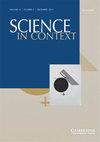从民权到后种族谎言:美国恐怖电影配乐中种族政治的表现
IF 0.5
4区 哲学
Q2 Arts and Humanities
引用次数: 0
摘要
自从电影出现以来,社会政治信息就一直在电影中可见。通过这项研究,我通过确定这些信息是如何通过电影的分数表现出来的,特别关注美国恐怖电影中的种族政治,来回应学术研究的空白。通过对电影配乐的讨论,无论是一般的还是特定于恐怖类型的,以及关于音乐中的文化认同的文章,我质疑如何使用这些理论框架,音乐可以被视为电影种族政治和潜台词的代表。我将重点关注五十年来上映的三部电影,每部电影都对当代美国的种族问题进行了评论。乔治·a·罗梅罗,1968);甜心宝贝(dir。伯纳德·罗斯,1992);和Get Out(导演)。Jordan Peele, 2017)。这项研究展示了许多电影配乐可以通过乐器、音色、预先存在的音乐、沉默以及这些元素所唤起的文化联系来表达潜台词的方式。本文章由计算机程序翻译,如有差异,请以英文原文为准。
From Civil Rights to the Post-racial Lie: The Representation of Racial Politics in the American Horror Film Score
Socio-political messages have been discernible in film since the advent of the moving image. With this study, I respond to a gap in academic research by establishing how these messages have been manifested through a film’s score, focusing specifically on racial politics within American horror films. Drawing upon discussions of film scores, both generally and specific to the horror genre, as well as writings on cultural identity in music, I question how, using these theoretical frameworks, music can be seen as representative of a film’s racial politics and subtext. I will focus on three films released over a fifty-year period that each provide commentary on race in the contemporary United States: Night of the Living Dead (dir. George A. Romero, 1968); Candyman (dir. Bernard Rose, 1992); and Get Out (dir. Jordan Peele, 2017). The study showcases numerous ways in which film scores can represent subtext through instrumentation, timbre, pre-existing music, silence, and the cultural associations that these elements evoke.
求助全文
通过发布文献求助,成功后即可免费获取论文全文。
去求助
来源期刊

Science in Context
综合性期刊-科学史与科学哲学
CiteScore
0.80
自引率
0.00%
发文量
1
审稿时长
>12 weeks
期刊介绍:
Science in Context is an international journal edited at The Cohn Institute for the History and Philosophy of Science and Ideas, Tel Aviv University, with the support of the Van Leer Jerusalem Institute. It is devoted to the study of the sciences from the points of view of comparative epistemology and historical sociology of scientific knowledge. The journal is committed to an interdisciplinary approach to the study of science and its cultural development - it does not segregate considerations drawn from history, philosophy and sociology. Controversies within scientific knowledge and debates about methodology are presented in their contexts.
 求助内容:
求助内容: 应助结果提醒方式:
应助结果提醒方式:


